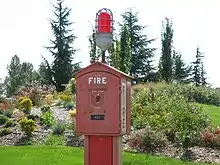Alarm device
An alarm device or system of alarm devices gives an audible, visual or other form of alarm signal about a problem or condition.

Etymology
The word Alarm comes from the Old French A l'arme meaning "To the arms", "To the weapons", telling armed men to pick up their weapons and get ready for action, because an enemy may have suddenly appeared.[1]
The word Alarum is an archaic form of Alarm, or a call to arms that often occurs as stage directions in Elizabethan Drama.[2] The term comes from Italian all'armi and appears 89 times in Shakespeare's first folio.[3] Often explained as the off-stage sounds of conflict or disturbance,[4] recent research suggests a bell or drum may have been used to rouse soldiers from sleep.[3]
History and development
Early alarm devices were often bells, drums or other musical instruments as well as other things that made unusual loud noises and attracted the attention of the surrounding population.
Whistles were used by Police in the 19th century, while steam whistles have been used on locomotives, ships and in factories as alarm devices.
With the coming of electricity, a variety of devices that make raucous sounds have been invented, including buzzers, klaxons, sirens, horns, as well as flashing and coloured lights and all purpose sounders.
Alarm devices can be fitted to buildings as well as vehicles. Many buildings are fitted with fire alarms, ranging from a self contained domestic smoke detector to sophisticated alarm system that can operate building fire fighting systems automatically to extinguish fires with water or inert gases.
Many industries have developed standards for alarm devices and the colours red, blue and amber are generally recognized as alarm device related colours, with flashing light often indicating an alarm condition is present.
Response to an Alarm
Human response or reaction to an alarm will often depend on training or the behaviour of others in the same environment. Consequently, the ability to test an alarm and hold regular drills or practice an appropriate response to important alarms may be provided as part of an alarm device.
Some alarms devices, such as fire alarms, which are intended to cause an occupied building to be evacuated, may be deliberate designed to make a space difficult or even painful to continue to occupy, in order to persuade occupants to leave.
Some alarms have the capability of causing a fight-or-flight response in humans; a person under this mindset will panic and either flee the perceived danger or attempt to eliminate it, often ignoring rational thought in either case. A person in such a state can be characterised as "alarmed".
False Alarm
With any kind of alarm, the need exists to balance between on the one hand the danger of false alarms (called "false positives") — the signal going off in the absence of a problem — and on the other hand failing to signal an actual problem (called a "false negative"). False alarms can waste resources expensively and can even be dangerous. For example, false alarms of a fire can waste firefighter manpower, making them unavailable for a real fire, and risk injury to firefighters and others as the fire engines race to the alleged fire's location. In addition, false alarms may acclimatise people to ignore alarm signals, and thus possibly to ignore an actual emergency: Aesop's fable of The Boy Who Cried Wolf exemplifies this problem.
Devices
There are many kinds of alarm devices. Those most commonly encountered included:
- an alarm clock which sounds an alarm at a pre-set time, often used to wake a person up or remind them of an event.
- a fire alarm which is used to give occupants of a building early warning of a potential fire and give them time to evacuate.
- warning devices on a vehicle that sound when it is moving in an unexpected direction, such as reversing,
- or on emergency vehicles responding to an emergency, usually a siren and often accompanied by flashing coloured lights.
Alarm devices, by category, include:
- burglar alarms, designed to warn of burglaries; this is often a silent alarm: the police or guards are warned without indication to the burglar, which increases the chances of catching him or her.
- alarm clocks can beep, buzz or ring off as an alarm at a set time to wake a person up or for other reminders
- distributed control systems (DCS), found in nuclear power plants, refineries and chemical facilities also generate alarms to direct the operator's attention to an important event that he or she needs to address.
- alarms in an operation and maintenance (O&M) monitoring system, which informs the bad working state of (a particular part of) the system under monitoring.
- safety alarms, which go off if a dangerous condition occurs. Common public safety alarms include:
- civil defense siren also known as tornado sirens or air raid sirens
- fire alarm systems
- fire alarm notification appliance
- "Multiple-alarm fire", a locally specific measure of the severity of a fire and the fire-department reaction required.
- smoke detector
- car alarms
- autodialer alarm, also known as community alarm
- personal alarm
- Video Alarm Verification System provides instant notifications upon the detection of a possible threat verified through a video feed.
- tocsin – a historical alarm mechanism
References
- "Definition of alarm".
- "Alarum". Dictionary.com. Retrieved 13 December 2020.
- Gillings, Mathew; Wilding, Luke (24 September 2017). "What did an "alarum" sound like?". Encyclopedia of Shakespeare's Language. Encyclopedia of Shakespeare’s language project. Retrieved 13 December 2020.
- "Alarum definition and meaning". Collins English Dictionary. HarperCollins Publishers.
